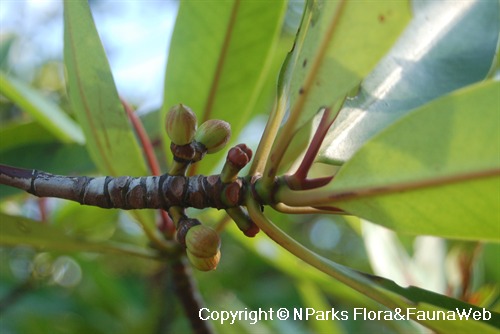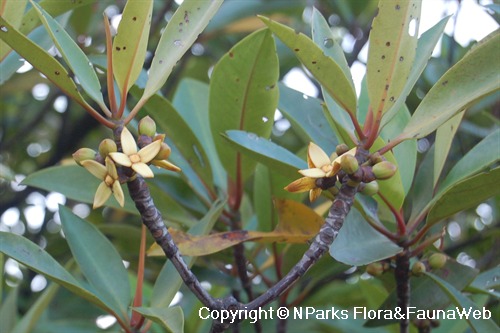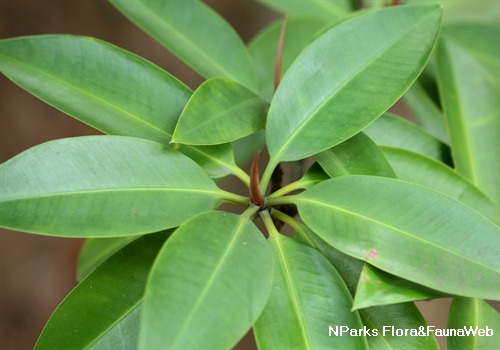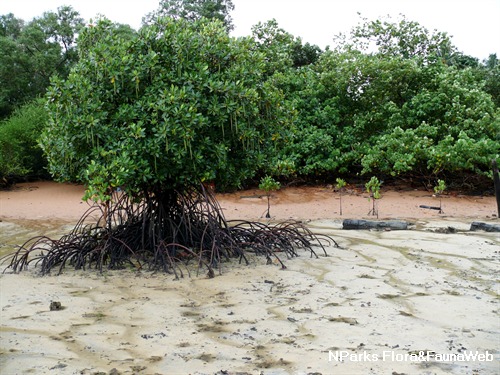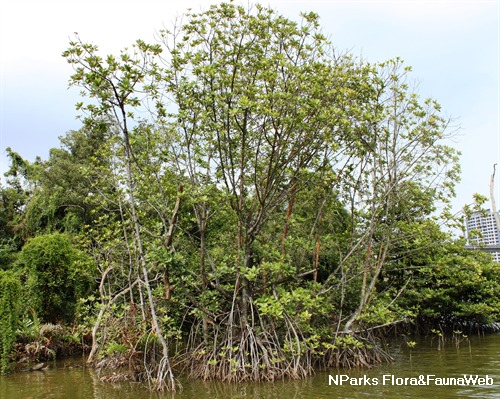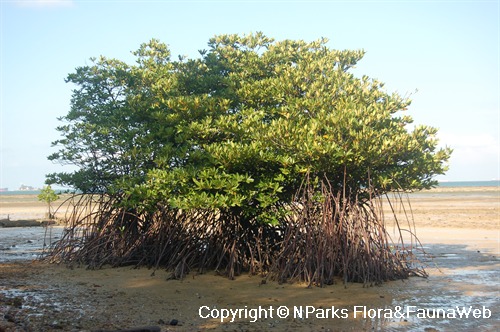
Back
Rhizophora apiculata Blume
| Family Name: | Rhizophoraceae |
| Synonyms: | Rhizophora candelaria, Rhizophora conjugata, Rhizophora lamarckii |
| Common Name: | Bakau Minyak, Bakau tandok, Bakau akik |
Name
Classifications and Characteristics
| Plant Division | Angiosperms (Flowering Seed Plants) (Dicotyledon) |
|---|---|
| Plant Growth Form | Tree (Big (>30m), Medium (16m-30m)) |
| Lifespan (in Singapore) | Perennial |
| Mode of Nutrition | Autotrophic |
| Plant Shape | Conical |
| Maximum Height | 20 m |
Biogeography
| Native Distribution | Sri Lanka, Southeast Asia, including Singapore, tropical Australia, Micronesia and the west Pacific Islands |
|---|---|
| Native Habitat | Shoreline (Mangrove Forest) |
| Preferred Climate Zone | Tropical, Sub-Tropical / Monsoonal |
| Local Conservation Status | Native to Singapore (Least Concern (LC)) |
Description and Ethnobotany
| Growth Form | Medium to large-sized erect mangrove tree growing up or over 30 m. |
|---|---|
| Crown | Conical crown |
| Trunk | Can reach up to 50 cm in diameter, bark is dark grey. |
| Roots | Conspicuous, arching stilt roots extending up to 5 m up the stem, and sometimes has aerial roots from the branches. |
| Foliage | Dark green, smooth and leathery leaves are ellipitic with entire leaf margin and reddish leaf stalks, measuring 7 - 19 by 3.5 - 8 cm. Long, red stipules emerge from the leaf bases. |
| Flowers | Flowers are composed of cream-coloured, linear petals arranged in a cross-shaped pattern. Prominent, yellow sepals are fleshy and wider than the petals. They occur in pairs and are held on dark grey stalks. Flower buds are broadly elliptic and finely fissured. |
| Fruit | Brown, pear-shaped fruit hang with the smaller end pointed down. A long, cylindrical seedling emerges from the smaller end, while the fruit is still attached to the parent plant. This condition is known as viviparity. |
| Habitat | Occurs on deep, soft and muddy soils that are flooded by normal high tides, sometimes tidal waterways with strong, permanent freshwater input is preferred. |
| Cultivation | The seedling, known as a propagule, is planted by placing it vertically in soil. |
| Ethnobotanical Uses | Timber & Products: Wood used for foundation piles, beams, outriggers of canoes, furniture, firewood and making of charcoal. Agriculture - Forestry: Sometimes planted along fish ponds to protect dikes and bunds. Others: This species' extensive set of prop roots help to disperse the destructive energy carried by strong tidal waves, helping to protect the shoreline and surrounding areas. |
Landscaping Features
| Landscape Uses | Coastal, Riverine |
|---|
Fauna, Pollination and Dispersal
| Pollination Method(s) | Biotic (Fauna) |
|---|---|
| Seed or Spore Dispersal | Abiotic (Water) |
Plant Care and Propagation
| Light Preference | Full Sun |
|---|---|
| Water Preference | Lots of Water |
| Plant Growth Rate | Moderate |
| Rootzone Tolerance | Waterlogged Soils |
| Propagation Method | Viviparious Propagule |
Foliar
| Foliage Retention | Evergreen |
|---|---|
| Mature Foliage Colour(s) | Green |
| Foliar Type | Simple / Unifoliate |
| Foliar Arrangement Along Stem | Opposite |
| Foliar Attachment to Stem | Petiolate |
| Foliar Venation | Pinnate / Net |
| Foliar Margin | Entire |
Floral (Angiosperm)
| Flower & Plant Sexuality | Bisexual Flowers |
| Flower Colour(s) | Cream / Off-White |
|---|---|
| Flower Grouping | Cluster / Inflorescence |
| Flower Symmetry | Radial |
| Individual Flower Shape | Cruciform / Cross-shaped |
Fruit, Seed and Spore
| Mature Fruit Colour(s) | Brown |
|---|
Image Repository
Others
| Master ID | 1973 |
|---|---|
| Species ID | 3265 |
| Flora Disclaimer | The information in this website has been compiled from reliable sources, such as reference works on medicinal plants. It is not a substitute for medical advice or treatment and NParks does not purport to provide any medical advice. Readers should always consult his/her physician before using or consuming a plant for medicinal purposes. |

